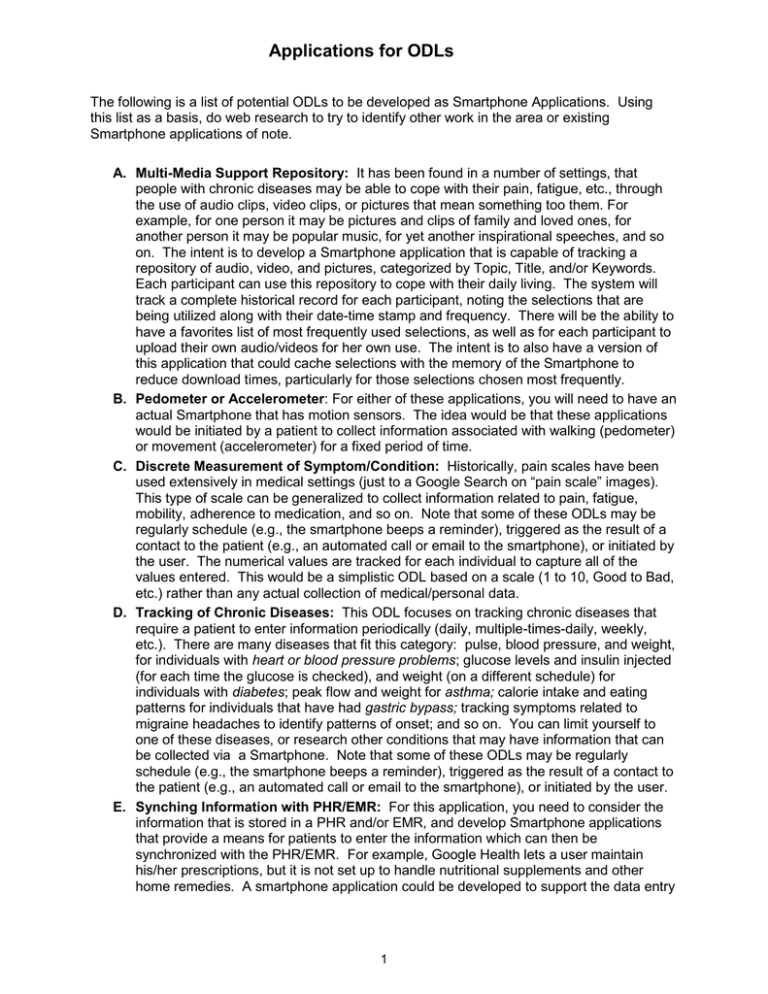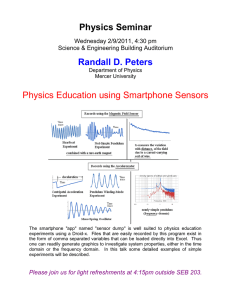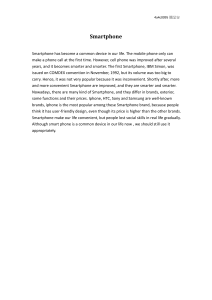Applications for ODLs
advertisement

Applications for ODLs The following is a list of potential ODLs to be developed as Smartphone Applications. Using this list as a basis, do web research to try to identify other work in the area or existing Smartphone applications of note. A. Multi-Media Support Repository: It has been found in a number of settings, that people with chronic diseases may be able to cope with their pain, fatigue, etc., through the use of audio clips, video clips, or pictures that mean something too them. For example, for one person it may be pictures and clips of family and loved ones, for another person it may be popular music, for yet another inspirational speeches, and so on. The intent is to develop a Smartphone application that is capable of tracking a repository of audio, video, and pictures, categorized by Topic, Title, and/or Keywords. Each participant can use this repository to cope with their daily living. The system will track a complete historical record for each participant, noting the selections that are being utilized along with their date-time stamp and frequency. There will be the ability to have a favorites list of most frequently used selections, as well as for each participant to upload their own audio/videos for her own use. The intent is to also have a version of this application that could cache selections with the memory of the Smartphone to reduce download times, particularly for those selections chosen most frequently. B. Pedometer or Accelerometer: For either of these applications, you will need to have an actual Smartphone that has motion sensors. The idea would be that these applications would be initiated by a patient to collect information associated with walking (pedometer) or movement (accelerometer) for a fixed period of time. C. Discrete Measurement of Symptom/Condition: Historically, pain scales have been used extensively in medical settings (just to a Google Search on “pain scale” images). This type of scale can be generalized to collect information related to pain, fatigue, mobility, adherence to medication, and so on. Note that some of these ODLs may be regularly schedule (e.g., the smartphone beeps a reminder), triggered as the result of a contact to the patient (e.g., an automated call or email to the smartphone), or initiated by the user. The numerical values are tracked for each individual to capture all of the values entered. This would be a simplistic ODL based on a scale (1 to 10, Good to Bad, etc.) rather than any actual collection of medical/personal data. D. Tracking of Chronic Diseases: This ODL focuses on tracking chronic diseases that require a patient to enter information periodically (daily, multiple-times-daily, weekly, etc.). There are many diseases that fit this category: pulse, blood pressure, and weight, for individuals with heart or blood pressure problems; glucose levels and insulin injected (for each time the glucose is checked), and weight (on a different schedule) for individuals with diabetes; peak flow and weight for asthma; calorie intake and eating patterns for individuals that have had gastric bypass; tracking symptoms related to migraine headaches to identify patterns of onset; and so on. You can limit yourself to one of these diseases, or research other conditions that may have information that can be collected via a Smartphone. Note that some of these ODLs may be regularly schedule (e.g., the smartphone beeps a reminder), triggered as the result of a contact to the patient (e.g., an automated call or email to the smartphone), or initiated by the user. E. Synching Information with PHR/EMR: For this application, you need to consider the information that is stored in a PHR and/or EMR, and develop Smartphone applications that provide a means for patients to enter the information which can then be synchronized with the PHR/EMR. For example, Google Health lets a user maintain his/her prescriptions, but it is not set up to handle nutritional supplements and other home remedies. A smartphone application could be developed to support the data entry 1 Applications for ODLs of this information, which would then be synchronized into Google Health, and if the user is also a patient with data in the EMR Centricity, a second step would synchronize to this repository using its secure web services. A different application could also be considered to handle side effects and reactions to medications, food, allergens, etc. This application would be textual/web based. F. Scanning/Recognition: For this application, it may be possible to leverage the digital camera in a cell phone to take a “picture” of a medication and/or nutritional supplement label that can be then uploaded to the web into the PHR or EMR. The idea would be for the patient to be able to create a pictorial representation of medications/supplements, that would also be supplemented with their complete dosing information (size, frequency, etc.). This would involve being able to capture perhaps multiple images from the same medication/supplement and meld them together. G. Futuristic Applications: If you want to push the boundaries of the technologies, this last set of applications could be very futuristic (with failure a strong potential). Examples include: a. Finding a commercial glucose meter (for diabetics) that can be hooked to a smartphone, so that the meter would automatically send the glucose level and time stamp. b. Using the digital camera on the smartphone as a scanner to scan bar codes on nutritional supplement bottles/boxes and prescription medications. This may also include optical character recognition to actually “read” the medication as it appears on the bottle. c. Hooking up a set of sensors through the port of a smartphone in order to collect different kinds of data – pulse, respirations, blood pressure. Perhaps there is a blood pressure apparatus that can be connected through the smartphone. You may also want to consider sensors that could detect movements at joints (hips, knees, arms, and legs). d. Thinking about how GPS can be utilized via the Smartphone to track movement in a more sophisticated sense the what is available through the sensors in the phone. e. OTHERS???? 2


